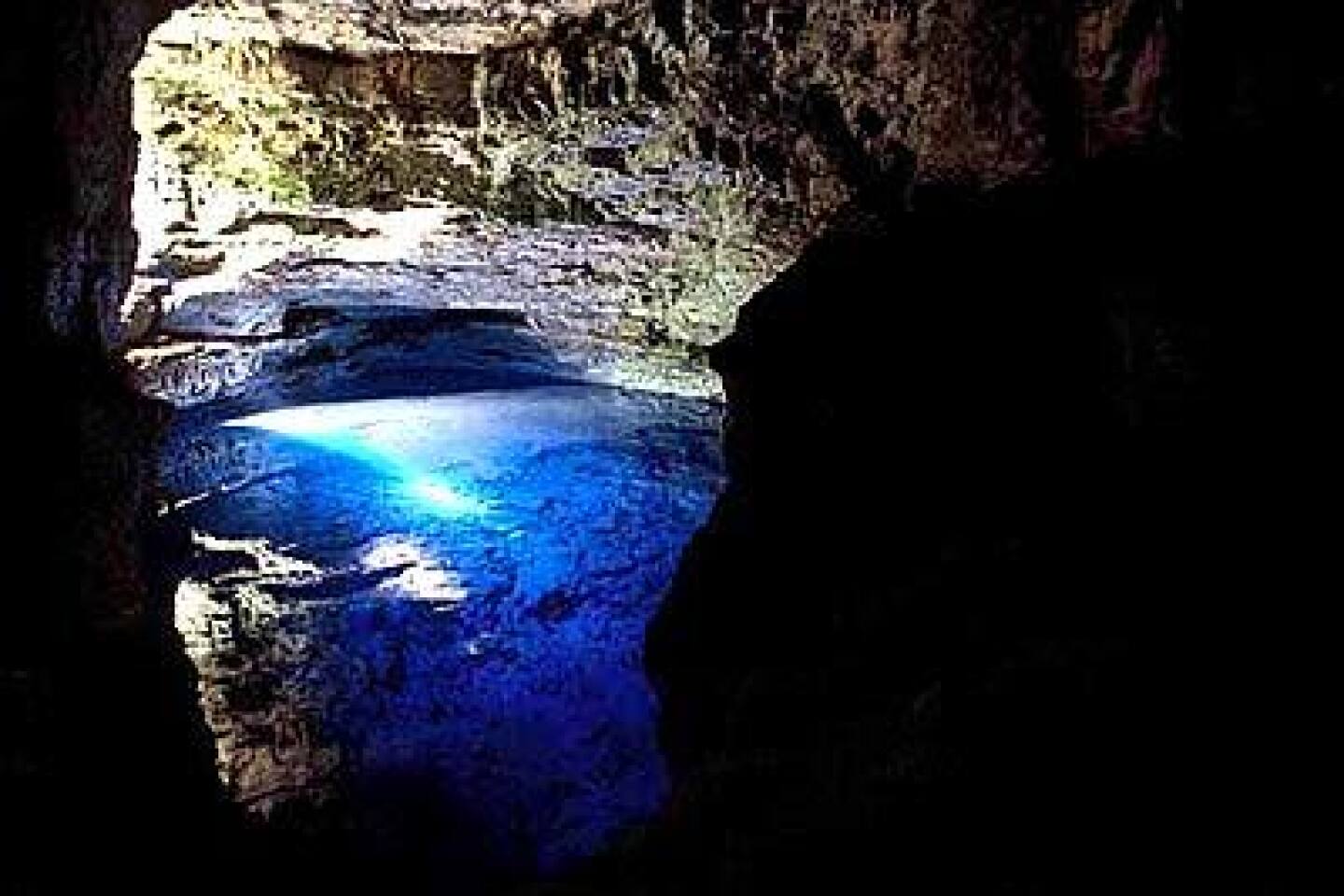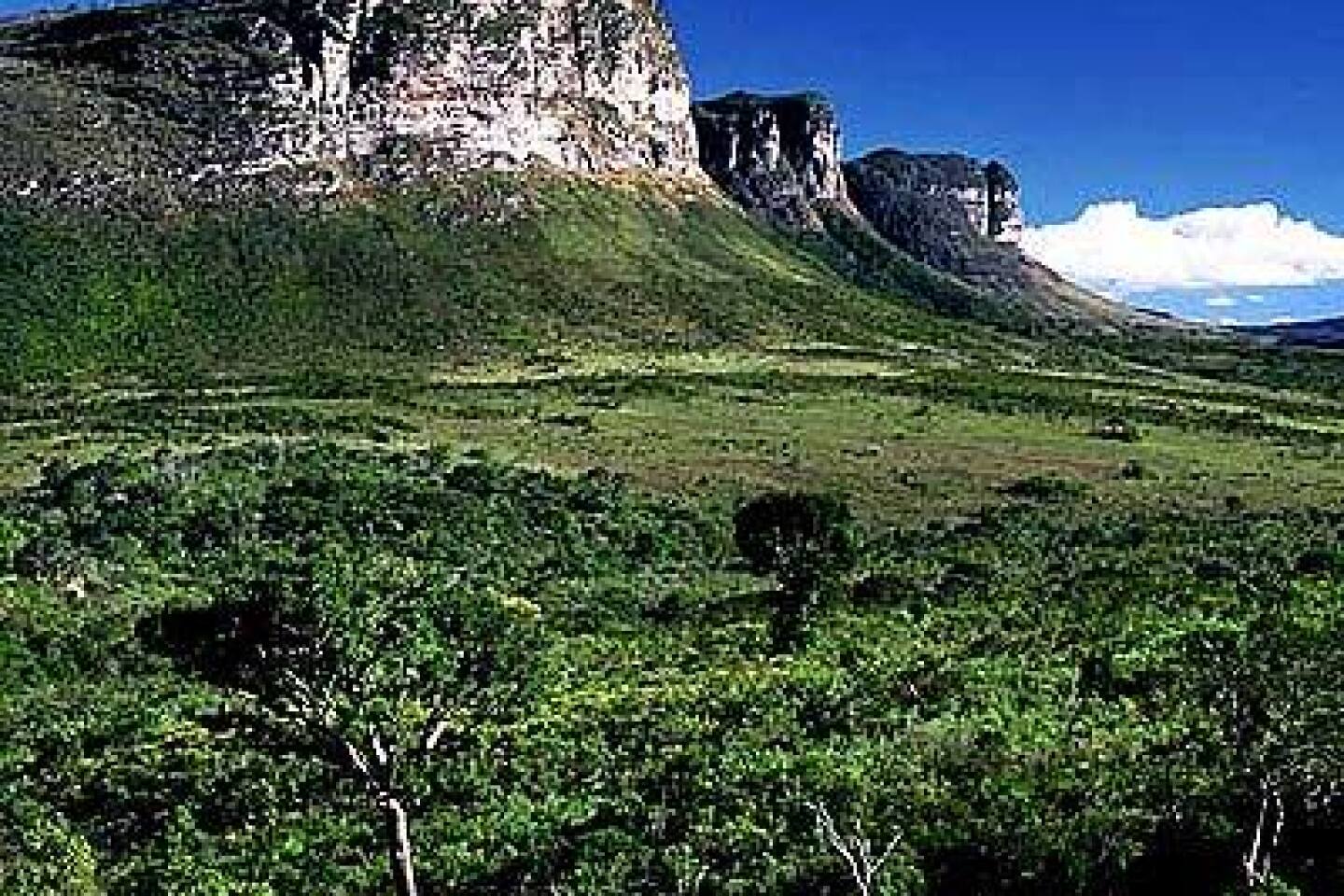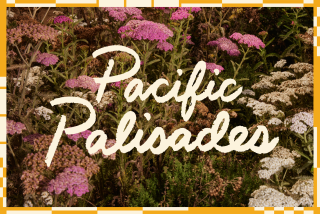The Chapadaâs wild wonders
Lençóis, Brazil
In the waning daylight, we scrambled to the top of the 3,600-foot sandstone butte named Pai Inacio and looked out on the row of mesas that stretched before us for miles, like giant soufflés. We were thrilled and awestruck by natureâs grandeur, millions of years in the making.
My 28-year-old daughter and I were dead tired after five days of hiking here in eastern Brazilâs Chapada Diamantina, or Diamond Highlands. The sight of the mesas bathed in the amber light of sundown was the climax of two weeks in the country. We knew our departure the next morning would be a sad one.
Maria Helene and I had come to 600-square-mile Chapada Diamantina National Park in the state of Bahia to hike and to immerse ourselves in Brazilâs natural wonders, among the worldâs most diverse. The exceptionally dramatic landscape is by turns lush and arid, with rocky peaks and Xanadu-like wetlands, picture-postcard waterfalls and eerily lighted underground caverns, all accessible within a park thatâs about half the size of Yosemite.
One bonus: We could see all of these wild wonders without abandoning creature comforts. Lençóis (pronounced len-SOIZ), the rejuvenated mining town that is the parkâs hub, is home to small but good hotels and restaurants.
I had been to Brazil and the Chapada many times, but this trip was Maria Heleneâs introduction. Would she swoon, as I had, at the regionâs natural beauty? Or would it pale compared with stopovers in Rio de Janeiro, about 750 miles south, and the Bahian capital of Salvador, 250 miles east? Atop Pai Inacio, Maria Helene shot me a wordless glance that said the Chapada had been worth the long trip and that she would be back.
A hub of eco-tourism
Our arrival in Lençóis in June made us bona fide participants in Latin Americaâs eco-tourism boom. Throngs of foreigners have been descending on out-of-the-way preserves to see nature up close and unadulterated and to escape their urban lives. Many perceive Latin America as less risky than Asia, Africa or Europe in this year of SARS, war and terrorism.Economics also plays a role. The devaluation of the Brazilian real since 1999 means the dollar goes a long way. Flights from L.A. to Rio de Janeiro compare favorably in price with flights to Europe, and once youâre in Brazil, accommodations and other travel expenses can be a relative bargain.
All of which explains why Brazil markets 50 eco-tourism destinations. The Chapada Diamantina is the most popular, last year drawing about 40,000 foreign visitors â a number that is growing 15% annually, local officials say.
Despite the rising popularity, crowds rarely are a problem. (Braziliansâ prime vacation season starts in December and runs to early March.)
Many of those who do journey here make their home base in Lençóis, a charming, 30-block collection of wildly colored buildings that seems frozen in time â about 1850, to be precise. Youâd never know from looking at the town that it had been a world center of diamond mining. For three decades after the first major gemstone discovery, in 1844, Lençóis was a boomtown every bit as wild as those of the California Gold Rush.
The city was a bustling commercial center, its diamond economy fueling imports of French fashions, German and British machinery, and Dutch butter and cheese. Work was started on a cathedral, and the townâs leaders even planned to build an opera house, similar to venues in the Amazon port cities of Manaus and Belem, just as the boom turned to bust.
By 1880 huge diamond deposits had been found in South Africa. Lençóis was largely abandoned, and its population had shrunk to a few hundred from a peak of 15,000. It remained a virtual ghost town until the 1970s, when eco-tourism stirred a rebirth.
These days the city has about 7,000 inhabitants, most dependent on tourism for their livelihoods. Lençóisâ eclectic, narrow, comfortably scaled buildings still line the cobblestone streets, one reason the town was declared a national historical monument in 1985.
Not to be dismissed as part of Lençóisâ appeal are, believe it or not, the culinary attractions. Estalegem Alcino, our little pousada (bed-and-breakfast inn), has been written up in Brazilian food magazines and international guidebooks for its original dishes â cassava pizzas, cheese crepes and tapioca croquettes, among others. Half a dozen exceptional restaurants in town provide welcome and reasonably priced rewards after a dayâs exertion on the trails.
Our inn had been remodeled by owner Alcino Caetano according to building plans dating to 1890. It was decorated with period photos and antiques that were just as old. Caetano, a former schoolteacher from Rio, opened his hostelry in 1992 as a way of escaping workaday drudgery and as an outlet for creative expression. He always seemed to be on the scene, tending to the next morningâs menu or working in his ceramics studio when he wasnât seeing to guestsâ needs.
Water, water everywhere
But the true draw here, without a doubt, is the land. The highlands were formed as cake-like layers of sediment collected on a primeval ocean floor. Hundreds of millions of years ago, the layers were pushed up by the same forces that ripped apart one landmass to form the continents of Africa and South America.The sandstone layer cake here was slowly whittled down by wind and rainfall. Whatâs left is an incredible variety of topography: mesas, canyons and caverns as well as rain forests, waterfalls and rivers. Dominating the tableau are the mesas that, when seen from Pai Inacio, resemble the Grand Canyon if it were tinged green. Dividing the plateaus is a grid of rivers and wetlands, fed by up to 7 feet of rainfall a year, that empty in the Paraguaçu River watershed.
Because of the abundant rainfall, water appears everywhere, including in the form of, among other things, swimming holes where hikers can refresh themselves. My favorite was at the bottom of the spectacular Ribeirao do Meio rock slide, a half-hourâs walk west of Lençóis. The Ribeirao River feeds the pond by way of a 100-foot natural cascade. A rigorous three-hour hike farther upstream takes you to more fabulous swimming at the foot of the Sossego waterfall, one of the most picturesque in the park.
But of the parkâs dozens of waterfalls, the most dramatic is Fumaça. The name means âsmoky,â a reference to the constant billowing of mist created by the fallsâ impact on the Capivara Valley floor. The water tumbles more than 1,100 feet straight down â a length almost equal to the Empire State Building. Fumaça was thought to be Brazilâs tallest waterfall until a bigger one was found in the Amazon. The view from the top is a panorama of the horseshoe-shaped valley beyond.
Another hike took us to the Lapao cave, an immense natural amphitheater whose geology resembles that of the caves inhabited by Indians in the American Southwest.
The underground Lapao River has slowly eroded the quartzite ceiling above, and the mouth of the cave is littered with massive sheets of broken rock that look as if they could have fallen yesterday.
Wildlife, minus the pests
Such grand sights turned out to be remarkably accessible and the park surprisingly easy to traverse.One day we took a seven-mile, all-day hike from the foot of Pai Inacio to Lençóis. Almost the entire route was on trails made with, or carved into, stone. Foot and mule paths and aqueducts constructed by miners during the diamond rush run from Lençóis like spokes of a wheel, making nature walks a lot less arduous.
The altitude, an average of 3,000 feet, means fewer bugs and temperatures that feel like an eternal spring. Visiting the Chapada is far different from walking through a Brazilian rain forest, where mosquitoes and other pests can be agonizing, even for those lathered in insect repellent.
âThe parkâs appeal is in that itâs a semitropical area with no tropical drawbacks, like diseases or creatures that will bite or eat you,â said Roy Funch, a former Peace Corps volunteer who settled here, led the effort to establish the national park in 1985 and now gives tours of the region. âThe pace of life is relaxed.â
Relaxed we were, taking in the Chapadaâs fascinating variety of wildlife. On a single day we saw a family of marmosets scrambling down a giant mango tree to beg for food; a moco, a rodent the size of a house cat, scampering across our trail; a 10-inch toad gobbling up moths beneath a street lamp; a tarantula; and a flock of shimmering green parrots fluttering across a river gorge.
A plant life extravaganza
What attracts naturalists even more is the plant life. On one walk I came across orchids, lichens, cactuses and bromeliads thriving within a few feet of one another. Hundreds of species are endemic to the zone. The flora is highly adaptive, often carving out an existence on bare rock and other unlikely surfaces.For orchid lovers like me, the Chapada is the mother lode. About 100 species live here. What makes the habitat special is that the bulk of the orchids are terrestrial, living on rocks and gravelly surfaces and not in trees, where theyâre often found elsewhere in the world.
We visited a privately owned botanical park called the Cultural Space of Pai Inacio, in the shadow of its namesake peak. Owner Luis Piedade has assembled for public viewing an incredible collection of orchids from the Chapada and the rest of Brazil.
Among the species are Cattleya elongata, the regionâs showiest orchid, which grows on rocky sandstone cliffs; and tour leader Funchâs favorite, Cyrtopodium edmundoi, which to the average passerby looks like a miniature palm tree. But when in bloom, the plant sends up a 4-foot stalk with 30 to 50 half-dollar-size flowers, creamy white with splashes of pink and maroon.
After just five days, it was time to leave, though we still had much left to see. As Funch told me, you need a month just to cover the Chapadaâs highlights. I regretted not taking Maria Helene to the renowned cavern named Poço Encantado, where, from April to August, a shaft of sunlight shoots through a window in the cavern wall, creating a magical blue luminescence.
Before catching the bus leaving town, we consoled ourselves with Caetanoâs breakfast. Over a table of spinach mini-pizzas, banana bread and passion fruit meringues, my daughter shot me one of her looks again. I knew what it meant.
*
(BEGIN TEXT OF INFOBOX)
Taking in the splendors of Chapada Diamantina
GETTING THERE:
From LAX, visitors to Chapada Diamantina National Park fly to Rio de Janeiro, then connect to Salvador, then connect again to Lençóis. Direct service (at least one stop, no change of planes) is on Varig. Connecting service (change of planes) originates on American, Continental and LanChile; the Salvador-to-Lençóis connection is on Varig and runs only on Fridays. Restricted round-trip fares start at $1,037.
Another option is to fly into Salvador and take one of two daily buses operated by the Real Expresso line. Itâs a six-hour trip each way. Tickets are $25 round trip. Information: 011-5571-246-8355, https://www.realexpresso.com.br (in Portuguese).
TELEPHONES:
To call the numbers below from the U.S., dial 011 (the international dialing code), 55 (country code for Brazil), 75 (city code for Lençóis) and the seven-digit local number.
WHERE TO STAY:
Estalagem Alcino, 139 Rua Tomba Surrao; telephone/fax 334-1171. Bed-and-breakfast in a vintage 1890 house lovingly restored by friendly owner-operator Alcino Caetano. Simple charm; clean and airy rooms; one of the best breakfasts, featuring imaginative menus changed daily and including all kinds of local dishes. Doubles $40 a night with private bath, $25 with shared bath.
Conto das Aquas Hotel, 01 Avenida Senhor dos Passos; 334-1154, fax 334-1279, https://www.lencois.com.br (in Portuguese, but photos and e-mail link may be helpful). At the edge of the Lençóis River. Pool. Doubles from about $45 a night, breakfast included; discounts during off-season and for extended stays.
Hotel de Lençóis, 747 Rua Altina Alves; 334-1102, fax 334-1201, https://www.hoteldelencois.com . A comfortable lodge built by the government in 1980 and since privatized. Good family atmosphere. Pool, bar. Doubles $45 a night, breakfast included; off-season and extended-stay discounts.
WHERE TO EAT:
Cozinha Aberta, 111 Rua da Baderna; 334-1066. Owner Deborah Doitshinoff will dazzle you with an eclectic menu that includes homemade pastas, Thai chicken and spicy dishes made with local vegetables, such as okra. Dinner for two with a bottle of good Brazilian red wine, $30.
Pousada Parador de Santiago, Avenida Cel. Jose Florencio (no street number, next to Mercado); 334-1083. Excellent beef and fish dishes, salads. Beer on tap. Dinner for two including beer, $25.
Os Artistas da Massa, 49 Rua da Baderna; 334-1886. Good Italian pastas, lasagnas. Entrees $8-$10.
ARRANGING HIKES:
Ask your hotel for help with planning tours. Hotels usually confer with operators to put you with groups of six to 10 people. English-speaking guides are available. You also can hire personal guides, usually for $12-$25 per person, per day, transportation not included. Recommended guides and operators: Roy Funch Guide Services, 212 Rua Pe da Ladeira, 334-1305, e-mail [email protected]; Pede Trilha, Praça Horacio de Matos, 334-1124, e-mail editora [email protected]; Lentur, 15 Avenida Sete de Setembro, 334-1271.
TO LEARN MORE:
Lençóis Tourism Office, Avenida Sete de Setembro, Lençóis, Brazil 46960-000; 334-1380.
Brazilian Tourism Office, 3006 Massachusetts Ave. N.W., Washington, DC 20008; (800) 727-2945, https://www.braziltourism.org . For visa information, contact the Los Angeles consular office, (323) 651-2664, https://www.brazilian-consulate.org .
â Chris Kraul
Chris Kraul is a Times foreign correspondent.
More to Read
Sign up for The Wild
Weâll help you find the best places to hike, bike and run, as well as the perfect silent spots for meditation and yoga.
You may occasionally receive promotional content from the Los Angeles Times.










